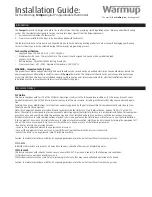
1
Electronic Thermometer
3000
AD/ADA
i.
abouT body TemPeraTure
It is a common myth that 98.6°F (37°C) is the “normal body temperature.” The truth is that 98.6°F (37°C) is an average body
temperature. Normal body temperature is actually a range that varies with age, gender, and measurement site. Body temperatures
also fluctuate through out the day, typically cooler temperatures in the morning, warmer in the afternoon, and cooling down again in
the evening. Other factors that can influence body temperature are: the patient’s recent level of activity, metabolism rate, or
medications. Normal body temperatures also tend to decrease with age.
Please see the chart below for normal temperature ranges by patient age and site. Readings from different body sites, even when
taken at the same time, should not be directly compared; body temperatures will vary by site.
References:
Chamberlain, J, Terndrup, T., et al. (1995) Determination of Normal Ear Temperature with an Infrared Emission Detection Thermometer. Annals of Emergency
Medicine, Volume 25, Issue 1, Pages 15-20
Braim. S., Preston, P., and Smith, R. (1988) Getting a better read on thermometry. RN. 1998 Mar; 61(3):57-60
Munk, P, Woods, S, Leduc, D., et al Canadian Paediatric Society Statement; Temperature Measurement in Paediatrics; Paediatric Child Health Vol 5 No 5: July/
August, 2000
Brunner, L. and Suddarth, Dl, et.al. (1982) The Lippincott Manual of Nursing Practice, Third Edition; J. B. Lippincott Company, Philadelphia, PA; 1982; p.1145
Houdas, Y. and Ring, E. F. J.. Human Body Temperature, Its Measurement and Regulation; Plenum Press, NY, 1982; p.81-87.
ii. General informaTion
1. The FILAC
TM
3000 electronic thermometer is a fast, highly accurate, and easy to use clinical instrument for measuring patient
temperatures by Oral, Axillary or Rectal means.
2. The electromagnetic compatibility of this device has been verified by test according to the EN60601-1-2:2005 requirements.
3. This device requires no user maintenance other than periodic cleaning and replacement of expired batteries.
features
•
Fast temperature measurements
Standard Mode - 6-10 second oral, 10-15 second axillary/rectal
Quick Mode - 3-4 second oral, 10-15 second axillary/rectal
Cold Mode - 12-15 second oral, 15-20 second axillary/rectal
•
Measurement range: 30°C to 43°C (86°F to 109°F)
•
Push button alternates Celsius/Fahrenheit scale
•
Audible indication of completion (“beep” sound)
•
Interchangeable, color-coded isolation chambers with matching probes.
Helps keep probe covers and probes together for aiding in infection control (Blue -oral/axillary; Red -rectal)
•
Easily wiped clean
•
Uses four standard disposable “AA” batteries
•
“Auto-On” when probe is withdrawn from the probe well
•
“Auto-Off” conserves battery life
•
Low Battery and Dead Battery indicators
•
Last temperature Recall
Temperature Site
Ear
Oral
Core
Rectal
Axillary
Normal Body Temperatures by Patients Age
>65 Years
96.4° - 99.5°F
35.7°- 37.5°C
96.4° - 98.5°F
35.7°- 36.9°C
96.6° - 98.8°F
35.8°- 37.1°C
97.1° - 99.2°
36.1°- 37.3°C
96.0° - 97.4°F
35.5°- 36.3°C
11-65 Years
96.6° - 99.7°F
35.8°- 37.6°C
97.6° - 99.6°F
36.7°- 37.8°C
98.2° - 100.2°F
36.7°- 37.8°C
98.6° - 100.6°F
37°- 38.1°C
95.3° - 98.4°F
35.1°- 36.8°C
0-2 Years
97.5°- 100.4°F
36.3°- 38°C
-
-
97.5° - 100.0°F
36.3°- 37.7°C
97.9° - 100.4°F
36.6°- 38°C
94.5° - 99.1°F
34.7°- 37.2°C
3-10 Years
97.0°- 100.0°F
36.1°- 37.7°C
95.9° - 99.5°F
35.3°- 37.5°C
97.5° - 100.0°F
36.3°- 37.7°C
97.9°- 100.4°F
36.5°- 38°C
96.6° - 98.0°F
35.8°- 36.6°C


































